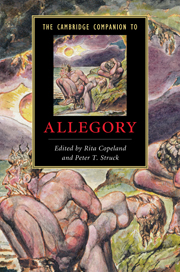Book contents
- Frontmatter
- Introduction
- Part I: Ancient foundations
- Part II: Philosophy, theology, and poetry 200 to 1200
- 4 Allegory and ascent in Neoplatonism
- 5 Allegory in Christian late antiquity
- 6 Allegory in Islamic literatures
- 7 Twelfth-century allegory: philosophy and imagination
- Part III: Literary allegory: philosophy and figuration
- Part IV: The fall and rise of allegory
- Further reading
- Index
7 - Twelfth-century allegory: philosophy and imagination
from Part II: - Philosophy, theology, and poetry 200 to 1200
Published online by Cambridge University Press: 28 January 2011
- Frontmatter
- Introduction
- Part I: Ancient foundations
- Part II: Philosophy, theology, and poetry 200 to 1200
- 4 Allegory and ascent in Neoplatonism
- 5 Allegory in Christian late antiquity
- 6 Allegory in Islamic literatures
- 7 Twelfth-century allegory: philosophy and imagination
- Part III: Literary allegory: philosophy and figuration
- Part IV: The fall and rise of allegory
- Further reading
- Index
Summary
Plato as a gentile counterpart to a Hebrew prophet, speaking a figural language . . . A rudimentary plea by a disorderly Prime Matter, providentially answered by the divine Mind . . . The divine words of Scripture not to be treated literally regarding the origin of Eve, who was created not from Adam but through the operation of nature . . . The figure of Nature herself circuitously complaining about the deviant grammar of fallen human nature . . . The whole Metamorphoses as an extended metaphor for the transformation of the soul . . .I
The transfiguration of allegory in twelfth-century Europe is so breathtaking that it can scarcely be framed in the conventional categories of an overview. It might be well to begin even a selective outline with an “inner view,” a self-conscious account of the language of allegory from a commentary written in the twelfth century. However partial and schematic, the passage displays a revealing moment at which an allegorical commentary turns into a metacommentary on allegory itself.
Names and natures
The general context of the passage – a fragmentary but extensive interpretation of the Aeneid – may well originate early in the century, although its exact date and the name of its author are not known.2 It is sometimes thought that the interpreter is Bernard Silvestris, the composer of the mid-twelfthcentury Cosmographia, one of the most spectacular cosmic narratives before the Mutabilitie Cantos of the English Renaissance. Whatever its provenance, the commentary is one of the most elaborate allegorical interpretations of an ancient poem (outside the poetry of Scripture) that survives from any time until the twelfth century itself.
- Type
- Chapter
- Information
- The Cambridge Companion to Allegory , pp. 101 - 116Publisher: Cambridge University PressPrint publication year: 2010
- 4
- Cited by



